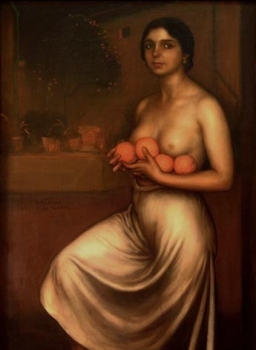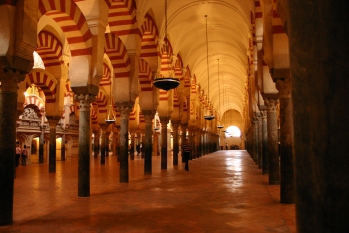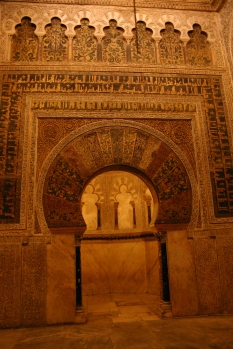3 December 2006
Penny & Greg's Spanish Siesta - Part 3
Cordoba
Following our animated and enlightening conversation with the “ten a day” man, we left Ronda at about 11.00 on our way to Cordoba. Eschewing the motorway and the main roads we travelled through some spectacular mountain scenery giving way to gentle rolling hills with wide vistas of olive groves as far as the eye can see. My goodness, there are a lot of olive trees in this part of the country! By the time we got to Aquilar de la Frontera, we were in need of some sustenance and the car was in need of some petrol so, having topped up we drove through the town looking for a place to have a bite to eat. After no time at all we stumbled across a very pleasant bar/café with a patio underneath some orange trees and we joined seemingly the whole neighbourhood out for Family Sunday Special. The place was packed and everyone was drinking, eating and talking vigorously while passing babies back and forth to be admired, cuddled and pinched. This would appear to be a regular Sunday occupation, presumably after Mass and, while the parents were not necessarily dressed as one might expect, all the children were clearly kitted out in their "Sunday Best” and everyone was clearly having a most pleasant early afternoon. Pen discovered "Albondigas" on the menu which reminded her of an occasion in both our dim and dusty collective memories when Aunt Lucinda made some albondigas soup which was enjoyed as much then as we enjoyed this Andalusían variety. And so, feeling suitably refreshed and replenished, we proceeded on our way to Cordoba, eventually arriving about 3.00. We parked the car somewhere near the centre of town and set out on foot looking for some suitably comfortable yet inexpensive hostelry for a couple of nights, eventually making our way down into the old part of town and discovering the Hotel Mastre which seemed appropriate for our needs. After settling our bags in the bedroom we set off on a brief stroll along the river to get our bearings ready for some serious sight-seeing in the morning. In particular, we were looking forward to the Mezquita and the Alcazar de los Reyes Cristianos (the Palace of the Christian Kings). The old town in Cordoba is wonderful – narrow alleys, courtyards and whitewashed buildings amongst which one can easily spend the occasional hour or so wandering aimlessly, which we managed effortlessly. After a most pleasant afternoon and evening, strolling and sight-seeing we found some places to indulge in some tapas and, after much debate, discussion and disagreement, eventually a restaurant for an evening meal and back to bed. Unfortunately, Spain tends to close down on Mondays so although the Mezquita was open, the Alcazar and a couple of other places we had intended to visit were not. I was particularly disappointed not to be able to visit the Museo Julio Romero de Torres (http://www.museojulioromero.com/index_firma.htm#). While I hadn’t been familiar with his work beforehand, Pen showed me a couple of postcards of his work and, in particular, his Naranjas y limones is a fine example of a young maiden demurely displaying some of her best assets alongside some oranges.
The Mezquita is quite simply stunning. (Pen says I am over-using the term “stunning” so I need to consult the thesaurus). The Mezquita is quite simply astonishing, startling, amazing, remarkable, dramatic, eye-catching, striking, dazzling, beautiful, gorgeous and, indeed, stunning. It is, of course, Cordoba’s great mosque which dates back to the eighth century and was once apparently the second largest mosque in the entire Moslem world. It started off with room for some four thousand of the faithful and, after subsequent enlargements over two centuries, ultimately had space for forty-thousand worshippers, each with his own prayer mat, kneeling and praying amongst the most wonderfully beautiful columns and pillars. The colour and light is magnificent and one can easily imagine the feeling of calm and serenity which one would have felt (and still does) when entering the building. Not surprisingly, when the Christians recaptured Cordoba they set about destroying the Moslem influence by dumping a monstrosity of a Catholic church smack in the middle of the mosque, clearly intending to subjugate the Moslems with the almighty power of the Catholic monarchy. Initially, there were a couple of chapels built and, of course, the Mosque was re-consecrated as a Catholic church. However, the most significant alteration was the construction of a Renaissance cathedral nave in the middle of the structure and it is this which so destroys the beauty, balance and serenity of the place. It was constructed by permission of Carlos V; once he saw what had been built, he supposedly exclaimed, "You have built what you or others might have built anywhere, but you have destroyed something unique in the world." It seems true, however, that the conversion of the mosque to a Christian church may have helped to preserve it when the Spanish Inquisition was at its most active and it is apparently well known that the locals, old Christians and converts alike, vehemently protected the monument after the city was regained by the Christian kings. Equally disquieting, I suppose, as the destruction of a beautiful building is the disgraceful opulence displayed in the treasury; at a time when the bulk of the population was living a subsistence existence much of the time, the wealth accumulated and displayed so grotesquely by the Church was (and is) simply obscene.
After visiting the Mezquita we did another bout of strolling through the old town exploring new alleys and courtyards and continuing the search for the restaurant of the day. Meanwhile, Pen had seen some leaflets advertising a performance of Flamenco dancing at the hotel so we found our way to the booking office to reserve a couple of seats for that evening’s performance. The gentleman in the booking office was very talkative and, after my halting efforts at communicating in Spanish had been acknowledged (and appreciated) we started a lengthy conversation about all manner of things. At one point our discussion touched on the attitude of youngsters today at the prospect of learning a foreign language. The agent lamented the fact that youngsters today simply did not apply themselves to their studies in the manner in which they should, in his view, and were always looking for a quick fix. In particular, he was dismayed by their relatively poor accents and we discussed how difficult it is for a native English speaker to make the appropriate sound for the “c” in gracias, for example. I guess most of us know that it is, in fact, a cross between the soft c or s sound and a “th” made with the tongue at the back of the teeth. In fact, of course, it’s a sound we do not have in English which makes it difficult to reproduce satisfactorily. After several attempts by me to pass muster on the “c/th” sound in Valencia and him correcting my accent, he finally remarked that youngsters could learn a decent accent if they were sufficiently determined – “Where there is a will, there is a way,” he said, “tu quoin a frase,” he continued. Now, Penny and I both thought he was attempting to teach us another Spanish phrase with immaculate pronunciation so Pen repeated, “Tu quoin a frase.” At this point, he repeated the phrase, “To quoin a frase” and she repeated it again. This “conversation” went back and forth each party seemingly trying to master the pronunciation and accent of the other. I can’t remember at what exact point the penny dropped or how many exchanges there had been by this time between Pen and our friend, but suddenly I realised what was happening and it took a monumental effort to prevent myself from laughing out loud. He was trying to say, “To coin a phrase” while Penny was trying to learn a new Spanish phrase. Each time she would repeat it, he was convinced that she was trying to help him with his accent and he tried to repeat it exactly as she was doing. However, she was trying to repeat it exactly as he was doing so they were gradually going around in circles, each time getting further and further from the original intent of the discussion. Finally, I had to interrupt the lesson and correct them both. “Oh, ‘to coin a phrase’ is what you’re after.” We shared much amusement for the rest of the trip (and, indeed, in the weeks since) at the services we were able to render to Iberian-Anglo understanding.
The Flamenco was due to start at 10.30 so we went along to the show after dinner. Spain, as you will have deduced already, is a late night kind of place. Although you can eat tapas all the time, you are lucky to find a restaurant for a proper dinner open before about 8.00 or half past. So, we ate out in the open in one of the plazas and then meandered down to the performance where we were greeted warmly and fulsomely by our new friend with the immaculate English accent. One has to admire the Spanish, or anyone for that matter, who can find such entertainment (or, to be honest, anything other than great humour) in what consists essentially of a couple of guitars accompanying someone or a couple of folks wailing seemingly disconsolately whilst two or three others stamp their feet rapidly and vigorously. Take the wailing and stamping and put it together with women with rather large backsides who seem, to judge by their facial expressions, to have a perpetually bad smell just under their noses and you just about have Flamenco summed up. Of course, I do it an injustice – it was highly entertaining and we only wish we could have understood what all the wailing was about. There’s no doubt, though, that it is a passionate and sensual expression of lust as well as, no doubt, treachery and disloyalty. And, the women did have large backsides. On the walk home after the performance Pen made me promise that I was not going to pull my underpants up around my arm pits and stamp my feet whilst wailing disconsolately once we got back to the security of our hotel room. And so, next week, the final instalment – Granada and the Alhambra. Some additional photographs from Cordoba Back to the Befouled Weakly News Index Back to Greg's Temporary Home Page
|





